Tuesday 27 November 2007
Thursday 14 June 2007
Postscript: Why does Mary matter?
- She lived at a time when very important events changed Scotland: Scotland changed from a Catholic country to a country dominated by Protestant ideas. Mary could have changed this but she did not.
- Mary’s son became King of both Scotland and England after Elizabeth died. British History was changed forever.
- Mary’s son James developed very strong ideas about the right of a King to rule. This was probably due to his ideas about his mother and her fate. He passed these ideas down to his son Charles I. Mary’s grandson Charles helped to cause a civil war in Scotland and England. This Civil War brought massive changes to Britain.
- Mary’s story is a very dramatic one. People are very divided in their views about Mary. You probably have your own ideas by now!
16. How was Mary affected?
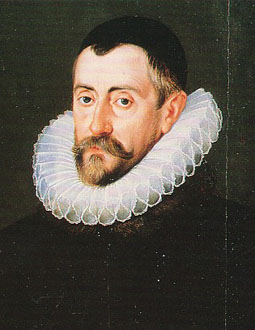 Francis Walsingham was a dedicated Protestant and Mary's mortal enemy. He employed top code breakers to de-cipher her letters
Francis Walsingham was a dedicated Protestant and Mary's mortal enemy. He employed top code breakers to de-cipher her letters- Her health suffered. This might have happened anyway but lack of exercise, cold damp castles and mental stress did not help.
- She got involved in plots with English Catholic groups. There was only ever hard evidence about the last plot – the Babington plot.
- Letters were smuggled to Mary in beer barrels. These letters were intercepted and de-coded by Francis Walsingham, Elizabeth's spy chief.
- In one of the letters, Mary agreed to become Queen of England after Elizabeth was murdered.
After a trial, Mary was found guilty of treason. - She was executed after a long period of "dithering" by Elizabeth.
15. How was Mary treated in England?
Elizabeth was in a difficult position …
Mary was a Queen and entitled to be treated like a Queen.
Mary was a Catholic and a possible successor to Elizabeth.
In the 1580s, the Pope declared that it was no sin for a Catholic to murder or be involved in a plot to murder Elizabeth.
So Elizabeth …
Started a tribunal / enquiry into the murder of Darnley. (A queen could not be tried by a court.) The Tribunal did not prove Mary innocent. Neither did it find her guilty. But the “Casket Letters” said to be written from Bothwell to Mary did a lot of damage to Mary’s reputation.
Kept her under guard in a series of castles. She was moved from the North. (Too close to Scotland and too many English Catholics) to the midlands of England.
Mary was a Queen and entitled to be treated like a Queen.
Mary was a Catholic and a possible successor to Elizabeth.
In the 1580s, the Pope declared that it was no sin for a Catholic to murder or be involved in a plot to murder Elizabeth.
So Elizabeth …
Started a tribunal / enquiry into the murder of Darnley. (A queen could not be tried by a court.) The Tribunal did not prove Mary innocent. Neither did it find her guilty. But the “Casket Letters” said to be written from Bothwell to Mary did a lot of damage to Mary’s reputation.
Kept her under guard in a series of castles. She was moved from the North. (Too close to Scotland and too many English Catholics) to the midlands of England.
14. Why did Mary leave Scotland?
 Loch Leven castle. This is where Mary was imprisoned after the battle of Langside
Loch Leven castle. This is where Mary was imprisoned after the battle of Langside- Her brother James returned from exile in England
- The nobles turned against Mary after the murder of Darnley and her marriage to Bothwell.
- A rebellion began and Mary was captured at Carberry. Bothwell was allowed to escape.
- Mary was imprisoned in a house in the middle of Loch Leven in Fife.
- She escaped by persuading one of her guards, a young boy, to help her.
- She gathered an army along with Bothwell.
- At Langside near Glasgow, her army was defeated and she escaped.
- Mary headed south to England, hoping that Elizabeth would help her against the rebels.
13. Why was Riccio murdered? What were the consequences?
- He had offended some of the nobles and he himself was a commoner (Talk about "playing with fire"!)
- Darnley and his supporters thought he was preventing Darnley from becoming King.
- There were rumours of an affair with Mary.
- Mary knew that Darnley was involved. (His dagger was left in Riccio's body)
Consequences
- Mary escaped from the nobles. Bothwell helped her. (Was this the start of their relationship?)
- The murderers escaped to England when Mary came after them with an army.
- Darnley's days were numbered. The murderers knew he had "double crossed" them by running away with Mary
- Several months later, Darnley was recovering from illness at a house just outside Edinburgh city walls. The house blew up but Darnley's body and that of a servant was found in the garden. Rumours spread that Mary and Bothwell had plotted to murder Darnley.
12. Was the marriage to Darnley a bad decision?
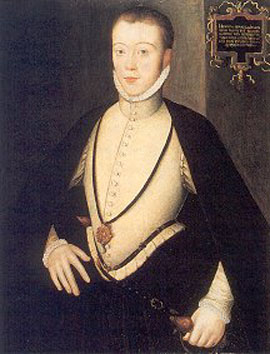 Henry Lord Darnley. Was he REALLY such a bad choice of husband?
Henry Lord Darnley. Was he REALLY such a bad choice of husband? YES: The marriage made some of the nobles angry.
Queen Elizabeth I was upset by the marriage.
Lord James Stewart led a rebellion against Mary. (The Chaseabout Raid)
The rebellion was ended and the nobles fled to England where they could still cause trouble for Mary.
NO: Darnley had a claim to the throne of England
The marriage would strengthen Mary’s claim to the English throne if she had a child.
Mary’s child by Darnley eventually succeeded Elizabeth and became James VI of Scotland and England.
11. What decisions did Mary make?
- She left the reformation in place. She did not try to return Scotland to the old religion.
- She gave money to support the new church.
- She allowed the Protestant lords to be on her Privy Council. (The committee which helped her to rule Scotland by giving her advice.)
- She put down a revolt by the Catholic Huntly family.
- She insisted on being allowed to practice her own religion in private.
- She did not interfere when Catholics who broke the new religious laws were punished.
- She married Henry Lord Darnley.
10. What problems did Mary have when she returned to Scotland?
 James Stewart was Mary's half brother. He had remained in Scotland when she was sent to France.
James Stewart was Mary's half brother. He had remained in Scotland when she was sent to France.- She was a Catholic Queen in a country which was now ruled by Protestants.
- Her half brother James was one of the leaders of these Lords. He was powerful but could never become King.
- She had to be careful not to upset the English / Queen Elizabeth I.
- Some Catholic nobles wanted her to overturn the reformation and go back to the old religion.
- She had to find a husband. He had to be strong enough to help her rule but he also had to be acceptable to Elizabeth I and also the Protestant Lords.
9. What changes did the new Protestant church bring in?
- The bible could now be printed in Scots and read by anyone who could read.
- The Catholic mass was banned. (But many noble families remained Catholics in private as did many poor families especially outside the major towns.)
- A General Assembly made rules for the whole church.
- A Kirk Session helped the minister to run a local church.
- People who broke the laws of the church were tried by the Kirk Session and punished. Scotland was to be a "Godly Community" .
- The church wanted to set up schools but did not have the cash. The nobles would not allow the new church to have the wealth and lands of the old Catholic church.
8. What happened during the revolution / reformation?
- Notices appeared on the doors of Friaries. They warned the Friars to get out or else. (These were known as the “Beggars’ Summons”)
- John Knox preached sermon in Perth which caused an anti Catholic riot.
- The French King sent more soldiers to help Mary of Guise.
- Elizabeth sent an army into Scotland. It defeated the French.
- The Treaty of Edinburgh ended the fighting. French and English forces would leave Scotland.
- A Parliament in Edinburgh agreed that Scotland would no longer be a Catholic country. It was illegal to say the Catholic Mass in public.
7. Why did a reformation / revolution take place in 1560?
 Queen Elizabeth I of England. She was a Protestant but she liked "bling"! She did not like the idea of the French controlling Scotland.
Queen Elizabeth I of England. She was a Protestant but she liked "bling"! She did not like the idea of the French controlling Scotland.- Elizabeth I became queen of England in 1558. She was a Protestant.
- Scotland was coming under the control of France. Elizabeth would never allow this.
- Protestant nobles were worried about French / Catholic influence. They joined together to form the Lords of the Congregation.
- The marriage of Mary and Francis took place in Paris. There were rumours about a secret part of the marriage agreement which would allow France to rule Scotland. These rumours were correct in fact.
6. Why did anti French feeling grow in Scotland?
 Protestant reformer John Knox was one of the leaders of the anti French group in Scotland. He had been involved with the group which murdered Cardinal Beaton and had served a sentence as a prisoner, chained to an oar on the French galleys.
Protestant reformer John Knox was one of the leaders of the anti French group in Scotland. He had been involved with the group which murdered Cardinal Beaton and had served a sentence as a prisoner, chained to an oar on the French galleys.- The pro English faction of the nobility hated being ruled over by Mary of Guise.
- All the nobles resented the growing power of Mary of Guise and her French supporters. They did not like the taxes needed to pay for them either.
- French soldiers sometimes caused trouble. They came to be seen as invaders rather than allies.
- The church did not do enough to reform itself. Cardinal Beaton burned Protestant preachers and this just created more sympathy for Protestant ideas. Protestant ideas therefore became stronger. This made the pro English faction stronger.
5. Why did the Rough Wooing take place?
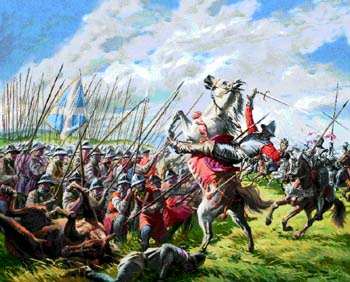 The Battle of Pinkie Cleugh was the last ever battle fought between English and Scottish armies. Henry VIII's army inflicted severe losses on the Scots.
The Battle of Pinkie Cleugh was the last ever battle fought between English and Scottish armies. Henry VIII's army inflicted severe losses on the Scots.- At first, the pro English faction came out on top (helped by cash from Henry VIII) …
- The Treaty of Greenwich was made with England : Mary would marry Henry VIII’s son Edward.
- The pro French faction made a come back (helped by French cash) …
- The Earl of Arran who was regent, switched sides. He then stood down in favour of Mary of Guise and Cardinal Beaton.
- The Scots then made the Treaty of Haddington with the French. Mary would marry the son of the French king and would go to France for protection.
- Henry VIII punished the Scots by sending English armies to lay waste the Borders and Edinburgh.. The Battle of Pinkie was the worst defeat. Several thousand Scots were killed.
This went on for several years until Henry VIII died. Henry's attacks on Scotland wee known as the "Rough Wooing"
4. Why did a crisis take place in 1542?
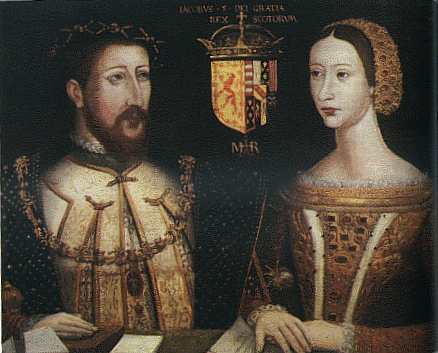 Mary's father and mother, James V and Mary of Guise. Mary was James' second French wife. He was committed to the alliance with France. This was the basic cause of the crisis in 1542.
Mary's father and mother, James V and Mary of Guise. Mary was James' second French wife. He was committed to the alliance with France. This was the basic cause of the crisis in 1542.- Scotland had been defeated by England at Flodden in 1513. This increased the power of the anti English faction in the nobility.
- James V had married two French princesses (the first died soon after arriving in Scotland) and renewed the alliance with France. This meant that Scotland was again “piggy in the middle” when England and France fell out.
- France and England fought and James V’s army was defeated at Solway Moss.
- James V died soon after the birth of his daughter Mary in 1542.
- The pro French faction fought with the pro English faction for control.
3. Why was the church criticised?
 George Wishart was a schoolmaster from Montrose. He was burned for heresy (preaching religious views which the church disapproved of) in 1546.
George Wishart was a schoolmaster from Montrose. He was burned for heresy (preaching religious views which the church disapproved of) in 1546. - The church was rich. Making money seemed to be more important than saving souls.
- Well paid jobs in the church were sometimes sold for cash. (This was called SIMONY)
- Nobles often got control of churches or monasteries and skimmed off the money. (This was called COMMENDATION)
- Some church officials took on several jobs and collected the cash from each but could not do all the work correctly. (This was called PLURALISM.)
- Church officials sometimes ignored the rules of the church and had sexual relationships. They used church money to support their mistresses and illegitimate children.
- Kings and nobles often forced the church to give jobs to their own illegitimate children. (This was called NEPOTISM.)
The church did make some efforts to REFORM itself but had little success.
2. In what ways was Scotland changing?
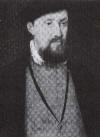
Archibald Douglas was the Earl of Angus. He was one of the leaders of the nobles who supported an alliance with England
- Relations with England were slowly getting better. James IV had married Henry VIII’s sister.
This created a pro English faction in the nobility. They wanted stronger ties with England. - New ideas were coming in from Europe – especially the new religious ideas which criticised the way the church was run.
Wednesday 13 June 2007
1. Why was Scotland a difficult country to rule?
 James IV was the grandfather of Mary Queen of Scots. He was involved in a rebellion against his father, James III. The nobles who rebelled had James III murdered. Not even Kings were safe in Scotland.
James IV was the grandfather of Mary Queen of Scots. He was involved in a rebellion against his father, James III. The nobles who rebelled had James III murdered. Not even Kings were safe in Scotland.- Scotland was poor. This was at the root of a lot of problems.
- The King was not much wealthier than some of his nobles. They were difficult to control.
- The nobles often fought amongst each other for wealth and power. Noble families formed groups against each other.
- There had been 300 years of warfare with England. Raiding and violence was common along the border.
- Scotland often got mixed up in wars between England and France.
Tuesday 12 June 2007
What this Blog is for.
Subscribe to:
Posts (Atom)
